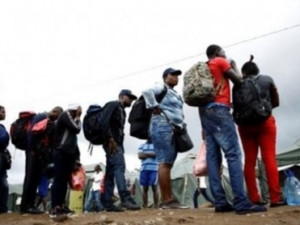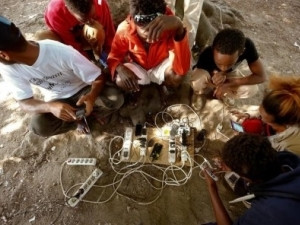
Our world is facing more humanitarian challenges than ever before. The UNHCR estimates over 65 million people were displaced by conflict and persecution in 2015 alone. At the same time, the Geneva Conventions are being ignored, with civilians and aid workers increasingly made targets of violence. And never have we been more informed or aware of these issues, due largely to widespread media coverage as well as social media.
Just as the manufacturing, technology, energy and service sectors, among many others, are struggling to evolve and realise the potential of the fourth industrial revolution, the humanitarian response must also transform.
"I have identified three actions that will play crucial roles in facilitating this transformation," says Elaine Weidman-Grunewald, Senior Vice-President and Chief Sustainability Officer at Ericsson. These are: adopting innovative technology to lessen the effects of conflict on areas like education; building new public-private alliances; and helping affected communities become more resilient and improve livelihoods.
With more than 7.5 billion mobile connections and 3.7 billion unique subscribers worldwide, mobile broadband has the potential to play a role unlike any other technology in supporting preparedness and response efforts.
Innovative technology like this enables the necessary reach, efficiency and data-driven decisions that can allow the best possible humanitarian response to develop. For example, it is increasingly popular to look at analysing mobility patterns during the Ebola outbreak in West Africa and the earthquake in Nepal through cellphone data, but we are arguably only at the onset of how data analytics will be applied in humanitarian contexts.
We also know that mobile networks, on a more basic level, facilitate access to life-saving information and enable those affected by crises and those providing much-needed assistance, including governments and the humanitarian community, to better communicate and coordinate relief efforts. In fact, all organisations are realising the benefits of technology in shaping more effective and efficient humanitarian response; it's just that not all organisations know what data to collect, what to do with the data, and what technology to use.
In a 2016 interview, David Miliband, President and CEO, the International Rescue Committee (IRC), revealed that he set up an independent research and development lab to develop technologies "ranging from malnutrition-measuring devices for nurses in Africa to computer-based education software for schools in refugee camps". I have had the opportunity to work with IRC in an educational context in Iraq, and have seen first-hand the benefits of connectivity in schools, says Weidman-Grunewald.
There is nothing more devastating in a disaster situation than to see children deprived of education for long periods of time. As the war in Syria drags on, there are children that have been out of the education system for five years now, which will lead to even greater lasting consequences for generations to come. Mobile networks can provide rapid access to content, and when combined with cloud-based ICT platforms, can give teachers access to comprehensive training materials. They can also provide ways for teachers to connect to each other to share strategies and resources across partner schools, as well as enhancing monitoring and evaluation capabilities.
As the gap in resources required to handle a humanitarian crisis versus what gets funded is widening, public-private partnerships are maturing as a means of fostering strong collaboration between different organisations to meet common objectives. While public-private partnerships can never offset the fundamental need of vital funding for organisations like IRC, World Food Programme and Red Cross, the private sector can and wants to do more. Private sector engagement can take many different forms, from philanthropy and donations to employee volunteerism, to lending its voice on policy issues, to what we at Ericsson call 'technology for good'. Regardless of the case, partnerships will become even more essential in the future, as the high cost and toll of emergencies requires more resources and solutions to address humanitarian challenges. With public-private partnerships, each party can focus on its core strengths.
Organisations working on the front line achieve amazing feats to restore order when order has been lost. We know today that the connectivity we provide is as vital as food, shelter and water, and we will continue to evolve with our partners and support them strategically and in their on-the-ground work.
Industry-wide initiatives can also play a role in public-private partnerships. One such example is the Humanitarian Connectivity Charter, launched by the GSMA at Mobile World Congress in March 2015. The charter is supported by the UN OCHA, the UN Emergency Telecommunications Cluster and the International Federation of the Red Cross and Red Crescent Societies. It was created to help strengthen access to communication and information during crises to reduce loss of life and positively contribute to humanitarian response.
Lastly, when it comes to improved livelihoods and affected populations, it is crucial to note that the average time a person is a refugee is 17 years, and around 59% of refugees and displaced persons live in urban areas. Such huge populations on the move defy the notion that refugees sit around in remote camps without access to anything. In fact, most refugees have mobile phones as they are considered vital tools for survival.
Mobile phones enable displaced people to:
* Reconnect with family members and loved ones;
* Access markets and make contacts to earn a living;
* Increase safety and security (especially for women and girls); and
* Transfer and receive cash.

As a member of the World Economic Forum's Global Future Council on Humanitarian Response, I am proud to join like-minded organisations to find more effective solutions. I approach the topic from the private-sector technology perspective, but we need both public and private partners to share in a common mission to lead change and improve coordination so millions more lives can be potentially saved in crisis situations. We all have the necessary skills, know-how, and resources that can make a real difference.
Share